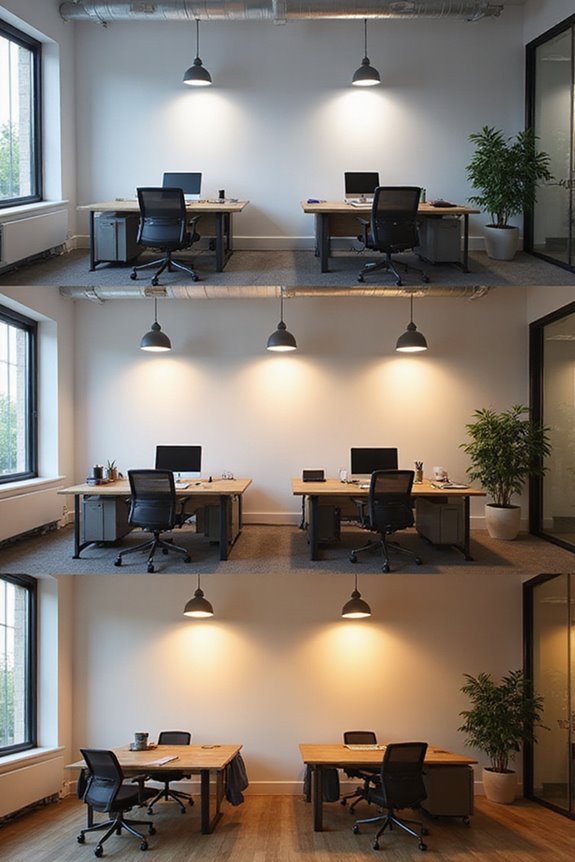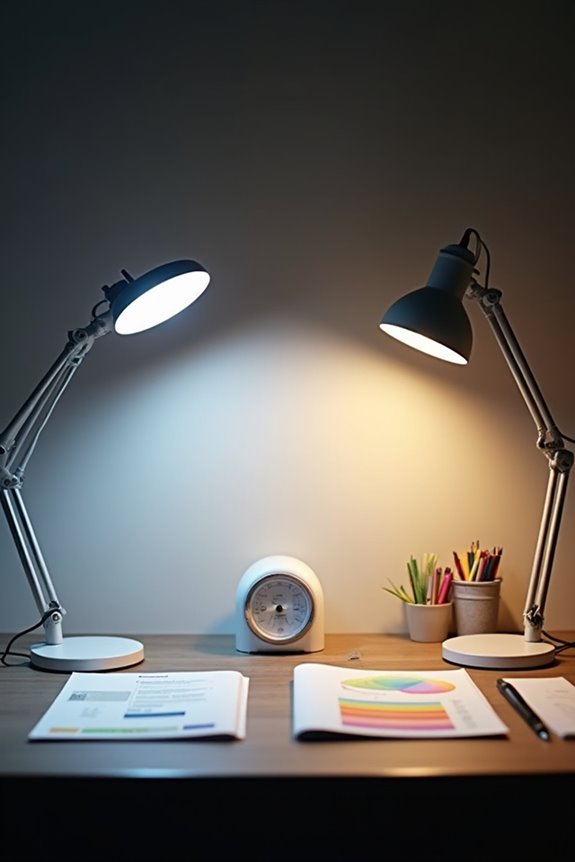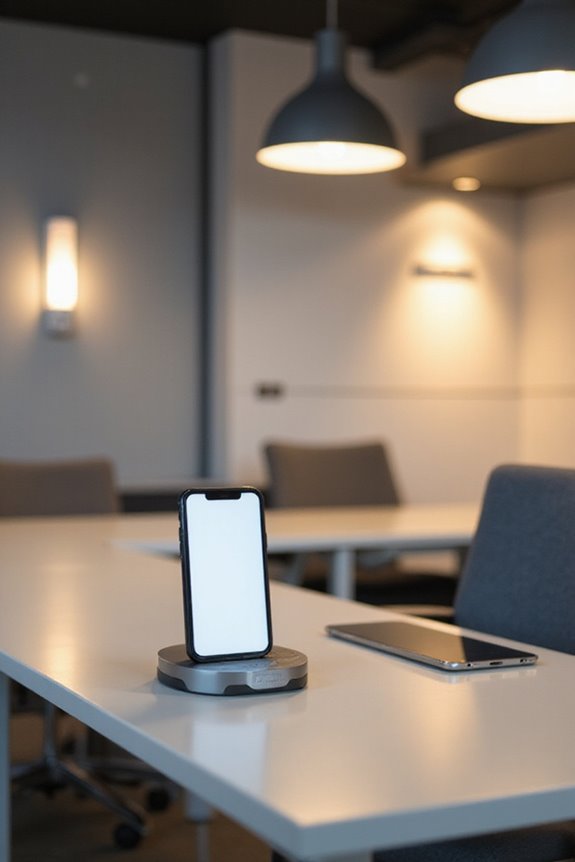Setting up proper task lighting starts with understanding its importance for reducing eye strain and boosting productivity. Choose energy-efficient LED bulbs for clarity, ideally with a color temperature between 3500–4500 K. Position your light source above or to the side of your workspace to minimize shadows and glare. Adjust brightness based on tasks—aim for 400–500 lux for reading. Finally, combine task lighting with ambient and accent sources for a balanced environment. You’ll find more insights on optimizing your space.
Key Takeaways
- Choose LED bulbs for task lighting to ensure energy efficiency, cooler color temperatures, and reduced glare.
- Position the light source directly above or at a 45-degree angle to minimize shadows and enhance visibility.
- Aim for 400–500 lux for general tasks, adjusting brightness for intricate work as needed.
- Implement layered lighting by combining ambient, task, and accent lighting for balanced illumination in your workspace.
- Use dimmable fixtures or adjustable lamps to easily switch between brightness levels based on the task and time of day.
Understanding the Importance of Task Lighting
Task lighting plays an essential role in creating an efficient and comfortable workspace. By providing targeted illumination, it enhances visual comfort, helping to reduce eye strain and prevent glare. This is particularly important when performing detailed tasks, as ideal lighting levels can greatly improve focus and productivity.
In addition to these benefits, task lighting also promotes energy efficiency. It consumes less energy than traditional overhead lighting, leading to cost savings and a lower environmental impact. Furthermore, adjustable task lights allow for customization, catering to individual ergonomic needs and preferences. This flexibility guarantees that you can create an environment that not only supports your work but also contributes to your overall well-being. Adjustable brightness in task lighting can further enhance comfort and productivity by allowing users to tailor the light intensity to their specific needs.
Choosing the Right Light Source
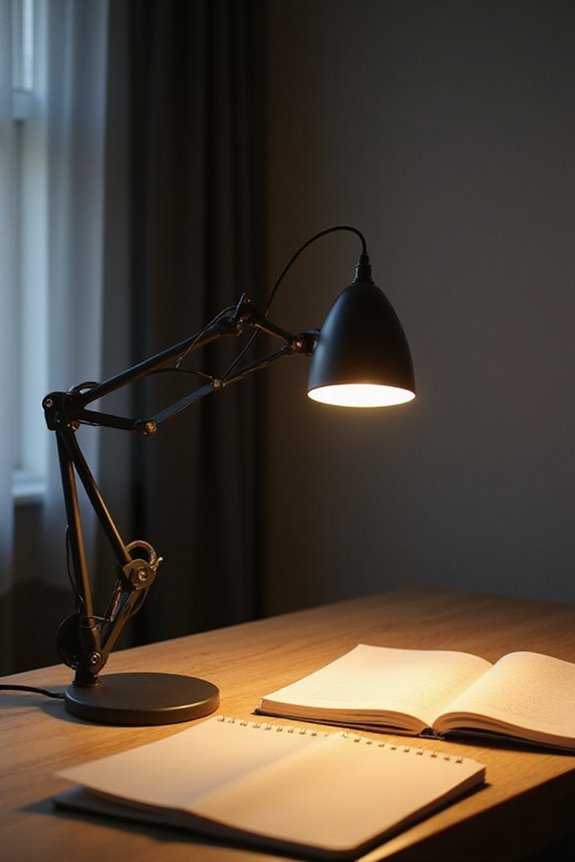
When it comes to optimizing your workspace for productivity, selecting the right light source is essential. I recommend considering LED benefits over incandescent options. While incandescent bulbs produce warm light, they often fall short for task lighting, leading to inadequate visibility. On the other hand, LEDs provide a cooler color temperature, typically between 3500–4500 K, which enhances contrast and clarity. Additionally, LEDs are energy-efficient, long-lasting, and can greatly reduce your energy costs. Compact fluorescent bulbs (CFLs) are another option, but I find LEDs to be more advantageous regarding brightness and heat management. Ultimately, choosing the right light source can greatly impact your focus and productivity levels. Moreover, many LED desk lamps feature eye-caring technology that reduces glare and minimizes blue light exposure, making them ideal for extended use.
Positioning and Placement Strategies
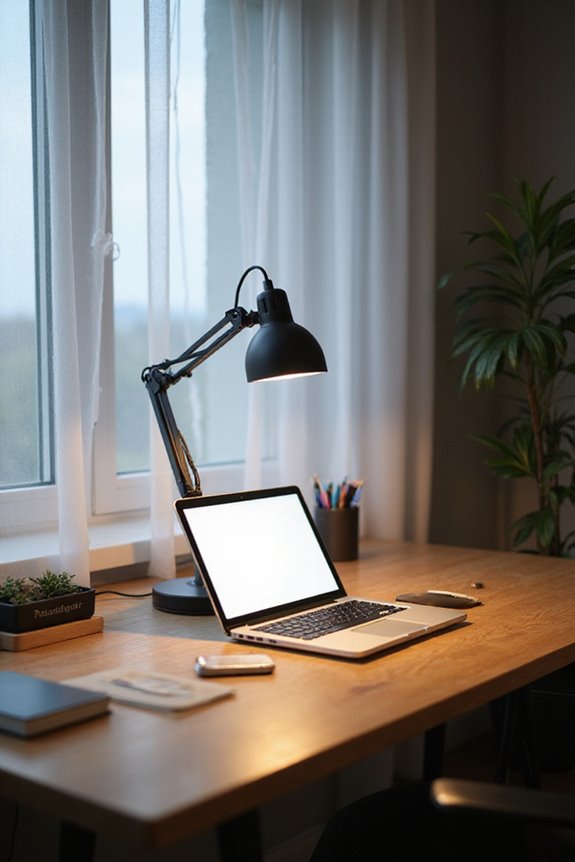
Positioning and placement strategies play an essential role in maximizing the effectiveness of your task lighting. To manage shadows, I recommend placing your light source directly above or slightly to the side of your workspace, ensuring it illuminates the area without creating direct shadows. Avoid background lighting, as it can lead to unwanted shadowing.
For glare reduction, adjust the lamp’s angle to prevent reflections on screens and consider using matte finish bulbs or diffused lampshades. Position your task lighting at shoulder level and at a 45-degree angle to your work surface for ideal illumination. By focusing your lighting on specific task areas, you can enhance visibility and comfort, ultimately improving your productivity.
Adjusting Brightness for Different Tasks
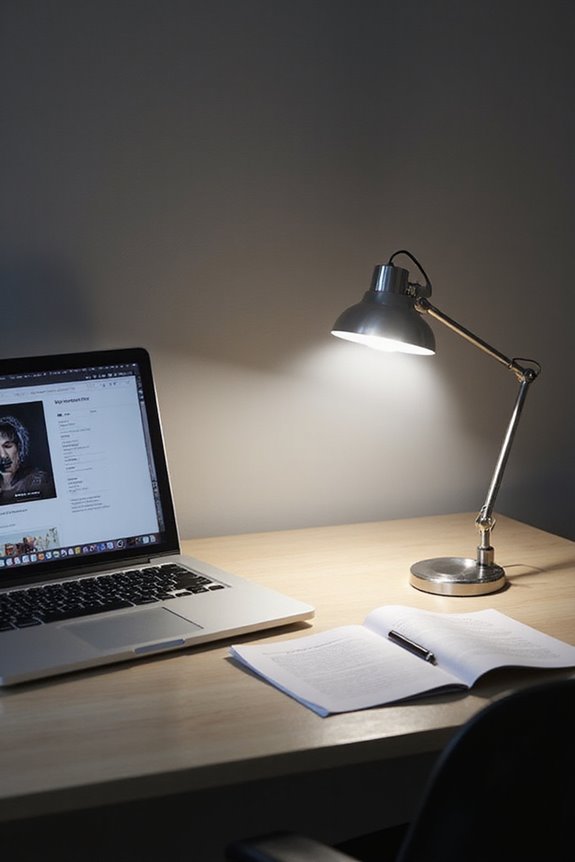
Adjusting brightness according to the specific tasks you’re performing can considerably enhance your workspace efficiency and comfort. Each task has its own brightness levels that cater to task-specific needs. For reading and writing, aim for 400–500 lux, while intricate work may require up to 750 lux. In the kitchen, make certain countertops have at least 400 lux, whereas bathroom tasks at the mirror should be around 300–500 lux. Crafting areas benefit from over 500 lux for detailed projects. By utilizing dimmable fixtures or adjustable lamps, I can easily switch between these brightness levels, guaranteeing ideal lighting for every activity. Tailoring my lighting setup based on tasks not only improves focus but also reduces eye strain.
Combining Lighting Types for Optimal Illumination
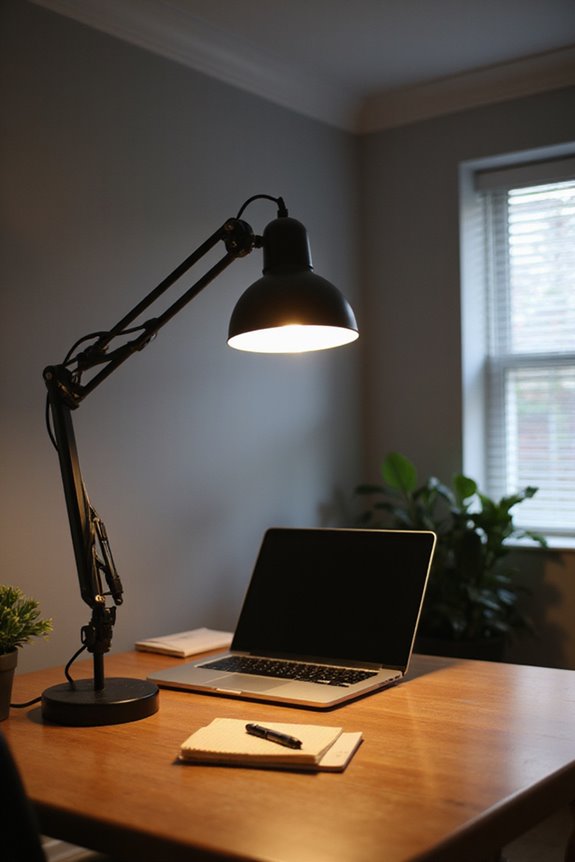
Combining different types of lighting in your workspace can greatly enhance both functionality and aesthetics. To achieve ideal illumination, I recommend implementing layered lighting, which includes ambient, task, and accent lighting. Ambient lighting provides the overall glow, while task lighting focuses on specific areas, like your desk. By using a mix of both, you can reduce harsh contrasts and guarantee even light distribution.
Accent lighting can highlight key features in your workspace, drawing attention to artwork or specific displays. I find that integrating natural light, when possible, further minimizes shadows and glare. Additionally, consider installing dimmer switches for flexibility, allowing you to adjust the brightness based on the time of day and task at hand. Incorporating energy-efficient lighting options can also contribute to long-term cost savings and environmental benefits.
Frequently Asked Questions
What Are the Best Color Temperatures for Task Lighting?
When I think about color temperature, I picture warm, cozy spaces or bright, energizing work areas. My lighting preferences lean towards 3,000K–4,500K for clarity and focus, ensuring I stay productive and comfortable.
How Can I Reduce Eye Strain While Working?
When I’m focused on eye care, I use effective lighting techniques like adjustable task lamps and indirect light. These help me minimize glare, ensuring a comfortable workspace and reducing eye strain throughout my day.
Are There Specific Lamps Recommended for Crafting Tasks?
Did you know that 80% of crafters report improved accuracy with proper lighting? I recommend OttLite and Cricut Bright 360 for their fantastic task lamp features, including adjustable angles and color accuracy—essential for any crafting project!
How Often Should I Adjust My Task Lighting?
I’d recommend adjusting brightness and lighting angles every 3–6 months. If you switch tasks or notice discomfort, don’t hesitate to make changes sooner. Staying comfortable is key to maintaining focus and productivity.
Can I Use Smart Bulbs for Task Lighting?
Did you know using smart bulbs can save up to $225 annually in energy costs? I love their adjustable brightness and customizable settings, making them perfect for task lighting while maximizing both efficiency and comfort.


